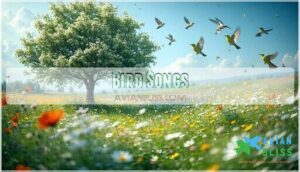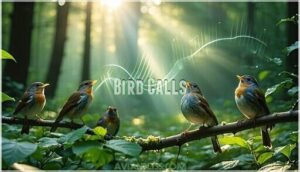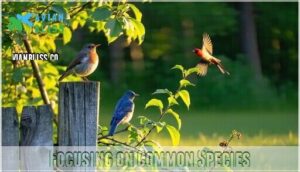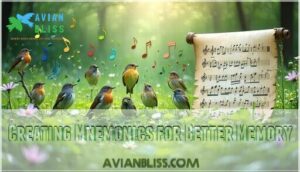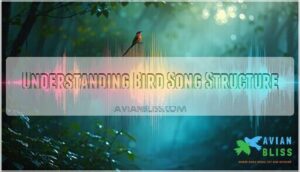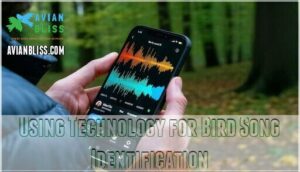This site is supported by our readers. We may earn a commission, at no cost to you, if you purchase through links.
 You’ll find bird identification becomes much easier when you focus on sounds rather than fleeting glimpses.
You’ll find bird identification becomes much easier when you focus on sounds rather than fleeting glimpses.
A good bird songs and calls guide teaches you to recognize different vocalizations through rhythm, pitch, and repetition patterns.
Start with common backyard species like robins and cardinals.
Their songs have distinct characteristics you can’t miss.
Use apps like Merlin Sound ID to practice.
Listen for the difference between territorial songs and quick contact calls.
Songs are usually longer and more complex.
Calls are short and functional.
Pay attention to when birds vocalize most actively during dawn and dusk.
The key lies in understanding what each sound actually means.
Table Of Contents
- Key Takeaways
- Learning Bird Songs and Calls
- Types of Bird Vocalizations
- Getting Started With Bird Song Identification
- Understanding Bird Song Structure
- Using Technology for Bird Song Identification
- Overcoming Challenges in Bird Song Identification
- Advanced Bird Song Identification Techniques
- Frequently Asked Questions (FAQs)
- How do you identify birds by their songs and calls?
- What is the free website to identify bird calls?
- What is the easiest bird call to learn?
- What do different bird sounds mean?
- What are bird calls?
- Do birds use sounds to communicate?
- Do birds sing songs or give calls?
- Where can I find a guide to bird sounds?
- How do you identify birds by song?
- Can you identify a bird by listening to its call?
- Conclusion
Key Takeaways
- You’ll identify birds faster by focusing on sounds rather than fleeting glimpses – start with common backyard species like robins and cardinals, then use apps like Merlin Sound ID to practice recognizing their distinct rhythm, pitch, and repetition patterns.
- You can distinguish between territorial songs (longer, complex melodies) and quick contact calls (short, functional sounds) by listening during dawn and dusk when birds are most vocally active.
- You’ll master identification by breaking down each sound into key elements – pay attention to duration, pitch changes, rhythm patterns, and complexity while creating personal mnemonics like "drink-your-tea" for Eastern Towhees.
- You can overcome challenging situations by using spectrograms to visualize sound patterns, seeking help from experienced birders in clubs or online forums, and practicing regularly in different environments to build your acoustic library.
Learning Bird Songs and Calls
You’ll discover that learning bird songs and calls opens up a hidden world where sound becomes your most powerful identification tool.
This skill helps you detect birds in dense forests and distinguish between species that look nearly identical but sound completely different, making sound a crucial element in bird identification.
Benefits of Identifying Birds by Song
Picture yourself walking through a forest where every chirp becomes a conversation you can understand.
Every bird call becomes a doorway into nature’s secret world of hidden conversations and ancient melodies.
Discover nature’s hidden soundtrack—where every chirp tells a story of life, survival, and connection.
Learning to identify bird sounds transforms ordinary walks into extraordinary adventures. You’ll develop Enhanced Awareness of your surroundings, spotting species hidden in thick foliage or active during twilight hours.
Bird sound identification helps you distinguish between look-alike species that visual cues can’t separate. Your efforts create real Conservation Impact through citizen science projects that track bird populations.
Each time you learn bird songs, you’re contributing Scientific Contributions to research databases. This skill offers Birding Accessibility for people with visual limitations or those exploring dense habitats.
You’ll form a Deeper Connection with nature as bird songs reveal territorial disputes, mating calls, and family communications happening all around you.
Essential Techniques for Bird Song Recognition
Now that you understand why bird song recognition matters, you can develop specific skills to master this rewarding practice.
Active Listening forms the foundation of successful bird sound identification. Train your ears to focus on one bird at a time, even when multiple species sing together.
Build your Vocalization Patterns library through these proven techniques:
- Practice Sound Visualization by sketching pitch changes on paper
- Use Mnemonics Creation like "drink-your-tea" for Eastern Towhees
- Apply Contextual Birding by noting habitat and season
- Record unfamiliar songs for later bird song analysis
- Compare similar species side-by-side during practice sessions
These methods accelerate your ability to identify bird sounds accurately.
Mastering Bird Song Identification
When you’re ready to take your bird song identification skills to the next level, focus on understanding each species’ unique acoustic environment. Every bird adapts its vocalizations to its surroundings, creating distinct patterns you can recognize.
Mastering bird songs transforms listening into a magical journey of discovery, connecting you with nature’s hidden symphony.
Pay attention to song variation within species – male cardinals sound different from juveniles. Regional dialects exist too; robins in California don’t sound identical to those in Maine. Some birds excel at mimicry, copying other species’ calls to confuse predators or attract mates.
Don’t get discouraged by the learning curve. Start with five common bird songs in your area. Use apps to analyze bird calls and bird sounds through spectrograms. Record local bird vocalization patterns, then compare them with field guides.
Join birding groups where experienced members share identification tricks. Practice daily, even for ten minutes. Soon you’ll recognize dozens of species by ear alone.
Types of Bird Vocalizations
You’ll hear two main types of bird sounds when you’re outside: songs and calls.
Songs are complex melodies that males use to attract mates and defend territory, while calls are shorter sounds birds make for everyday communication like warning others or staying in touch with their flock.
Bird Songs
Bird songs are complex musical performances that showcase nature’s acoustic artistry.
You’ll discover that male birds primarily sing these elaborate melodies during breeding season to establish territory and attract mates.
Unlike simple calls, songs demonstrate remarkable vocal sophistication through intricate patterns and extended duration.
Song complexity reveals three fascinating elements:
- Regional dialects develop as birds learn from local neighbors, creating unique variations
- Song learning occurs during critical developmental periods, similar to human language acquisition
- Song evolution shapes species-specific melodies over generations through natural selection
These melodic masterpieces require dedicated practice, making bird song identification both challenging and rewarding.
Bird Calls
Listen closely—those quick chirps you hear aren’t random chatter. Bird calls serve as nature’s emergency broadcast system and social network rolled into one.
Every chirp is nature’s breaking news—urgent messages flying through the air at the speed of sound.
Unlike songs, calls are brief, functional sounds that get straight to the point. Alarm calls pierce the air when danger lurks nearby, warning every bird within earshot.
Sharp, urgent notes that make you stop and scan the sky for hawks. Contact calls keep flocks connected during flight—soft peeps that say "I’m still here" without attracting predators.
Begging tweets from hungry chicks demand immediate attention. Parents recognize their offspring’s unique vocal signatures among dozens of other young birds.
This flock communication creates invisible threads connecting birds across landscapes, making species recognition and survival possible through avian vocalization.
Differences Between Songs and Calls
Why do some bird sounds make your heart sing while others just grab your attention? The difference lies in understanding songs versus calls – two distinct forms of avian vocalization that serve unique purposes in bird communication.
Bird songs are complex, melodious performances that showcase song complexity and vocal learning. Males typically sing these elaborate compositions during breeding season to attract mates and defend territories. Think of them as nature’s love ballads.
Bird calls, however, are short, functional sounds used year-round for immediate communication needs. Call function includes alarm signals, flock coordination, and contact calls.
Context matters when identifying these bird sounds:
- Songs occur mainly during breeding season and dawn chorus
- Calls happen throughout the year for practical communication
- Species variation creates unique vocal signatures for each bird
Getting Started With Bird Song Identification
You’ll find that learning bird songs becomes much easier when you start with just a few common backyard species like American Robins and Northern Cardinals.
Focus on the key sound details like pitch and rhythm while you practice with recordings, and you’ll build a solid foundation for identifying more challenging species later.
Focusing on Common Species
Master your bird identification journey by starting with the voices you hear every day right outside your door. Focus on these four common bird songs that’ll build your confidence:
- Robins Song – that cheerful "cheerily-cheer-up" melody that greets each morning
- Cardinals Call – the clear "birdy-birdy-birdy" whistle that cuts through any neighborhood chatter
- Jay Chatter – those harsh, unmistakable calls that announce every backyard drama
- Goldfinch Twit – the sweet "po-ta-to-chip" flight call that bounces through the air
These backyard bird songs form your foundation for North American bird songs. You’ll recognize patterns faster when you start with familiar species.
Each Oriole Whistle or repeated call becomes a stepping stone to identifying trickier species. This bird song guide approach works because your brain connects new sounds to ones you already know.
Paying Attention to Sound Details
Once you’ve picked your starter species, sharpen your listening skills by breaking down each sound into pieces.
Your acoustic environment holds countless sound nuances that separate one bird from another.
These subtle variations become your contextual clues for reliable bird sound identification in any setting, using complete concepts and understanding the acoustic environment.
Using Recordings and Study Aids
Once you’ve sharpened your listening skills, recordings and study aids become your best friends for mastering bird sound identification.
Quality playback devices make all the difference when studying bird songs at home.
Download apps like Merlin or explore sound libraries such as the Macaulay Library, which houses thousands of professional bird recordings.
These resources let you replay tricky calls until they stick.
Recording quality matters when capturing your own bird audio in the field.
A decent smartphone with a good microphone works fine for beginners.
Visual aids like spectrograms help you see sound patterns alongside what you hear.
Practice with familiar species first, then expand your repertoire.
Here’s your action plan:
- Download free bird song apps for instant access to thousands of recordings
- Create a personal collection of local bird calls using your smartphone
- Study spectrograms to visualize how different species sound unique
Many enthusiasts purchase specialized birding products to enhance their experience.
Creating Mnemonics for Better Memory
After building your sound library through recordings, mnemonic creation becomes your secret weapon for bird song learning.
Transform the Baltimore Oriole’s whistle into "here-here-come-right-here" or the White-breasted Nuthatch’s nasal call into "yank-yank."
Personal mnemonic creation works best when you craft phrases that click with your own experiences.
Share your bird song mnemonics with fellow birders—mnemonic sharing often reveals clever associations you hadn’t considered.
While sound-association techniques boost mnemonic effectiveness, remember these memory tricks have mnemonic limitations with complex songs requiring multiple approaches for complete bird sound identification in your bird calls guide.
Understanding Bird Song Structure
You’ll identify birds more accurately when you understand the four key elements that make up every bird song: rhythm, pitch, repetition, and tone.
These structural components work like a bird’s musical fingerprint, helping you distinguish between species that might sound similar at first listen, using elements like repetition.
Rhythm
Bird song rhythm varies dramatically between species, creating distinct call patterns you can learn to recognize.
Notice how a Chipping Sparrow delivers rapid, steady notes while a Wood Thrush spaces melodic phrases with pauses.
Rhythmic variation helps distinguish similar birds—listen for tempo changes and song cadence differences.
Seasonal rhythms also shift as breeding behaviors influence bird song duration and intensity patterns.
Pitch
Mastering pitch recognition reveals the secret language of birds around you. Your ears become finely-tuned instruments, detecting the subtle frequency differences that separate one species from another.
Understanding bird song pitch patterns reveals these key insights:
- High pitched warblers sing in frequencies that dance above human conversation
- Low pitched ravens rumble with bass notes that echo through forests
- Changing pitches create melodic signatures unique to each species
Pitch variation transforms random noise into meaningful identification. When you’re studying a bird song spectrogram, notice how frequency shifts tell stories. This bird sound ID skill makes every outdoor adventure an exciting discovery mission through nature’s orchestra.
Repetition
Beyond pitch variations, you’ll discover that bird song repetition creates each species’ unique vocal fingerprint.
Most birds use repeated phrases like nature’s broken record, making identification easier once you recognize their patterns.
Bird songs with consistent repetition help you memorize species faster.
The Chipping Sparrow delivers steady trills, while Song Sparrows mix bird song variations within their vocal repertoire.
Call evolution shaped these patterns over millions of years.
| Bird Species | Repetition Pattern | Identification Difficulty | Common Habitat | Peak Singing Time |
|---|---|---|---|---|
| Chipping Sparrow | Steady trill | Easy | Backyards | Dawn-morning |
| Song Sparrow | Mixed phrases | Moderate | Wetlands | All day |
| Carolina Wren | Complex sequence | Hard | Dense brush | Year-round |
| White-breasted Nuthatch | Simple calls | Easy | Tree trunks | Morning |
| Wood Thrush | Flute-like phrases | Moderate | Forest understory | Evening |
Sound mimicry and song learning create fascinating bird song patterns you’ll encounter during your identification journey.
Tone
The vocal timbre of each species creates a unique sonic fingerprint that transforms bird song identification from guesswork into precision.
Sound modulation reveals emotional states—from gentle whispers to urgent warnings. Your aural perception sharpens as you decode these subtle variations in bird sounds.
- Bright tones signal courtship energy in avian sounds
- Harsh calls indicate alarm or territorial disputes
- Soft whistles suggest contentment or communication
Call intensity and song quality distinguish species instantly.
Bird call types range from Cedar Waxwing’s squeaky notes to Pine Warbler’s buzzy drone. Each bird song tone tells its story.
Using Technology for Bird Song Identification
Technology has made bird identification much easier for beginners and experts alike.
Modern apps like Merlin Sound ID can identify bird songs in real-time while spectrograms help you see sound patterns to understand what you’re hearing, making use of real-time analysis.
Sound ID Apps
Technology puts bird identification at your fingertips.
Sound ID apps turn your smartphone into a portable birding companion that recognizes bird songs and bird sounds instantly.
These bird audio identification tools work with offline functionality, ensuring you can identify species even without internet connection.
| Feature | Performance |
|---|---|
| Identification Accuracy | 85-90% success rate |
| Recording Quality | Clear audio in quiet environments |
| Global Support | 1,000+ species worldwide |
| App Comparison | Five major apps available |
Most bird recording identification apps struggle with complex songs but excel at simpler calls.
Many users find specialized products useful for enhancing their birding experience.
When choosing between options, consider your local bird species and recording quality needs for ideal results.
Merlin Sound ID
Sound ID apps provide a solid foundation, but Merlin Bird ID app takes bird audio identification to the next level.
This free tool from Cornell Lab delivers impressive Merlin accuracy across global support regions, covering over 1,000 species worldwide.
Here’s what makes Merlin your go-to bird song identification tool:
- Offline capabilities work without internet connection
- Real-time recognition of bird songs and calls
- Extensive species coverage across multiple continents
- Future updates continuously expand the database
- Visual sound spectrograms complement audio identification
Simply open the app, hit record, and watch as Merlin analyzes bird sounds in real-time.
The technology learns from millions of recordings, making it incredibly reliable for identifying everything from common backyard birds to rare species during your travels.
Using Spectrograms for Sound Analysis
Beyond Merlin’s instant identification, spectrograms transform bird sounds into visual maps you can read like sheet music.
These graphs show pitch on the vertical axis and time horizontally, with brightness indicating loudness.
You’ll spot unique patterns – a robin’s liquid phrases versus a cardinal’s sharp whistles.
Spectrogram basics help decode complex avian acoustics for precise bird sound analysis.
Overcoming Challenges in Bird Song Identification
You’ll face real challenges when identifying bird songs in the field. Background noise can mask calls, and many species sound remarkably similar to each other.
Dealing With Similar-Sounding Species
Many species share similar sounds, creating mimicry challenges for birders.
Regional accents vary between populations, while hybrid songs blend characteristics from different species.
Age differences affect vocal quality – juveniles sound different from adults.
Environmental impact also changes how you hear calls.
Focus on rhythm patterns and pitch changes in your bird songs guide to master bird species identification through birding by ear.
Identifying Birds in Noisy Environments
City streets create a cacophony that masks bird songs, but smart noise reduction strategies help you succeed at urban birding.
Filtering sounds becomes easier when you cup your hands behind your ears or use directional microphones as equipment choices for serious enthusiasts.
Focus on distinctive patterns rather than volume when practicing birding by ear.
Move away from traffic when possible, and time your bird sound recognition sessions during quieter morning hours when ambient noise levels drop naturally.
Seeking Help From Experienced Birders
Every birder encounters puzzling bird sounds that leave them scratching their heads.
When you’re stumped by a mysterious call or song, don’t hesitate to seek guidance from seasoned bird sound experts who’ve been there before.
The birdwatching community welcomes newcomers with open arms, offering multiple pathways to enhance your bird identification skills:
- Birding clubs provide hands-on field experience with local experts who know regional species intimately
- Expert workshops offer structured learning environments where you’ll master advanced bird identification tools and techniques
- Online forums connect you instantly with knowledgeable birders worldwide who can help identify challenging sounds
- Mentorship opportunities pair beginners with experienced guides who follow proper guiding ethics while sharing decades of birding wisdom
Remember, every expert started as a beginner.
Embrace the learning process, ask questions, and watch your identification abilities soar through community support.
Advanced Bird Song Identification Techniques
You’ve learned the basics of bird song identification, but now you’ll need expert methods to identify challenging species.
These advanced techniques help you match visual clues with sounds, use technology effectively, and analyze complex song patterns with precision.
Connecting Bird Appearance to Song
Visual-Song Link connects what you see with what you hear. Small birds like goldfinches produce high-pitched songs, while larger birds like thrushes create deeper melodies.
Plumage and Song patterns often match – bright warblers deliver complex tunes, while brown sparrows offer simple chips. Notice how Size and Pitch relate directly.
Behavior and Song work together too. Woodpeckers drum on bark, while ground-dwelling birds sing from low perches.
Color and Call combinations help narrow choices. This bird identification approach transforms birdwatching into detective work, making bird vocalizations easier to remember and recognize.
Using Field Guides and Apps
Once you’ve connected a bird’s looks to its sounds, technology becomes your secret weapon.
Modern bird apps and digital guides transform your smartphone into a portable identification powerhouse.
Your bird guide identification toolkit should include these must-have features:
- Real-time sound recognition that works without internet
- Extensive species coverage for your region
- Regular updates frequency to stay current with new discoveries
- High app accuracy ratings from fellow birders
Digital bird app identification tools can’t replace experience, but they’ll speed up your learning dramatically.
Most quality apps offer offline access, so you won’t get stuck when cell towers disappear.
Check guide limitations before heading out – some focus on specific regions while others cover entire continents.
Many users find specific bird sound apps especially helpful for identification.
Cross-reference multiple sources when you’re stumped.
Your bird songs guide becomes more reliable when you combine traditional field guides with cutting-edge bird app technology.
Practicing Regular Listening
Daily practice transforms your listening skills from amateur to expert level.
Schedule focused sessions of 15 minutes each morning, using active listening techniques to identify nearby species.
Visit different locations throughout the week – parks, forests, wetlands – since location variations reveal new voices.
Pay attention to seasonal changes as spring brings different songs than winter calls.
This consistent birding by ear approach builds your bird sound identification guide expertise naturally over time.
Utilizing Spectrograms for Sound Analysis
Once you’ve sharpened your regular listening skills, spectrograms reveal bird sound mysteries through visual frequency analysis.
These scientific tools transform songs into colorful graphs showing pitch changes over time.
Spectrogram Basics reveal what your ears might miss:
- Frequency Analysis – See high and low pitches as vertical patterns
- Loudness Visualization – Bright colors show volume intensity
- Song Structure – Identify repeated phrases and note sequences
- Species Comparison – Compare similar-sounding birds side-by-side
Bird song research relies heavily on these sound recordings.
Modern bird song technology makes spectrograms accessible through apps like Merlin, turning you into a bird sound analysis expert who reads songs like sheet music.
Frequently Asked Questions (FAQs)
How do you identify birds by their songs and calls?
Start by learning familiar species like robins and cardinals.
Listen to their pitch, rhythm, and patterns.
Use mnemonics like "Who cooks for you" for barred owls.
Practice with apps and field recordings regularly.
What is the free website to identify bird calls?
You’ll find bird-sounds.net offers free identification by uploading recordings.
Merlin Bird ID by Cornell Lab also identifies calls in real-time using your phone’s microphone, working offline worldwide for instant results, with Merlin Bird ID being a key tool.
What is the easiest bird call to learn?
The American Robin’s cheerful song is perfect for beginners.
You’ll hear its liquid warble year-round, especially at dawn.
Listen for the rhythmic "cheerily-cheer-up-cheerio" pattern – it’s distinctive and easy to remember once you’ve heard it.
What do different bird sounds mean?
Like nature’s own morse code, bird sounds carry specific messages you can decode.
Songs attract mates and claim territory.
While calls serve practical purposes—warning of danger, begging for food, or keeping flocks together during flight.
What are bird calls?
Bird calls are short, functional sounds you’ll hear birds make for specific communication needs.
They’re used for alarms, keeping flocks together, or signaling danger – unlike longer, more complex songs used for mating.
Do birds use sounds to communicate?
Ever wonder how birds coordinate their daily lives.
Yes, birds rely heavily on sounds for communication.
They use songs to attract mates and defend territory, while calls serve specific purposes like warning of danger or maintaining flock contact.
Do birds sing songs or give calls?
You’ll hear birds produce both songs and calls, but they serve different purposes.
Songs are complex melodies males use for attracting mates and defending territory, while calls are shorter sounds for everyday communication.
Where can I find a guide to bird sounds?
You’ll discover thorough bird sound guides through the Audubon Bird Guide App, Cornell’s Merlin Bird ID, and Peterson Field Guides.
These digital and print resources contain thousands of recordings from songbirds across North America for identification practice.
How do you identify birds by song?
You’ll identify birds by song through active listening and pattern recognition.
Start with familiar species, note pitch changes and rhythms.
Use mnemonics like "Who cooks for you," and practice regularly with field apps.
Can you identify a bird by listening to its call?
Yes, you can identify birds by their calls with practice.
Start with common species in your area. Listen to recordings regularly.
Pay attention to pitch, rhythm, and patterns. Apps help, but your trained ear works best.
Conclusion
Like Sherlock Holmes solving mysteries through subtle clues, you’ve now gained the detective skills needed for bird identification.
This bird songs and calls guide provides seven proven steps to transform you from a confused listener into a confident identifier.
Start with common backyard species and practice daily, use technology wisely but trust your ears.
Remember that each song tells a story about the bird’s behavior and needs, and your patience and consistent practice will reveal nature’s hidden vocal conversations.
- https://www.birds.cornell.edu/clementschecklist
- https://docs.google.com/forms/d/e/1FAIpQLSfRzI7u7H3ieNKNIwU7ezmPPF98c5cHNeCzJnro8xe1k9JUbQ/viewform?usp=sf_link
- http://mailto:macaulaylibrary
- https://search.macaulaylibrary.org/catalog?mediaType=audio
- http://biology.allaboutbirds.org/features/bird-song-hero/bird-song-hero-challenge

